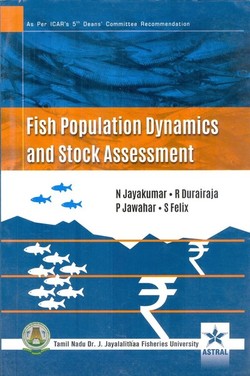
Fish Population Dynamics and Stock Assessment
By
N. Jayakumar & R. Durairaja & P. Jawahar and S. Felix
Preface
Fish stock assessment in tropical waters has made remarkable renaissance in the last few decades. As most of the stocks of commercially important species of India are getting reduced due to increase in fishing effort, cut down in effort is needed. Further, restriction in the catch of juvenile fish could be advised on the basis of knowledge about the growth rate during the first years of the life of the fish. In tropical countries like ours, where we have multi-species fisheries, estimate of age and growth, mortality, standing stock biomass and yield per recruit are more difficult because of the prolific breeding nature of the species. Hence methods normally used for the stock assessment for temperate fishes are not applicable to tropical species. Keeping the above in view, a book entitled, "Fish Population Dynamics and Stock Assessment" has been prepared. This publication brings out all the methods in detail and emphasis has been placed on these methods which are tailored to the need of students and researchers and scientists involved in Fish Stock Assessment.
Fisheries tend to collapse because of fleet over-capacity, leading to harvesting the stocks of fish beyond their ability to recover. On the other hand, fish stocks may also be under-utilized because of fleet under-capacity. The fishery managers have to strike a balance by directly controlling the fishing capacity (input control) and/or by setting restrictions on the catch (output control). The key factor in the success of striking this balance is the application of fisheries management based on scientific advice coming from results of stock assessment models. This book entitled "Fish Population Dynamics and Stock Assessment" has been written to meet the requirements of graduate, post graduate students, researchers and scientists in fish stock assessment. Written in a textbook form, this book encompasses the knowledge of principles of stock assessment, sampling techniques, age determination, growth parameters, mortality parameters, gear selection, stock assessment models, fisheries management etc. If this book could help and guide the students and researchers, we shall feel amply rewarded. The book contains 16 chapters that have been explained very clearly with numerous illustrative examples, leaving no scope for confusion.
Contents
1 – Introduction
2 – Principles of Stock Assessment
3 – Data Requirement of Stock Assessment
4 – Biological Structure of Fisheries Resource in Space and Time
5 – Indicators of Dynamics in Fishery Resource
6 - Sampling Techniques
7 – Age Determination in Fish
8 – Stock Structure Analysis
9 – Growth Models
10 – Mortality Parameters
11 – Gear Selection
12 – Surplus Production Models
13 – Analytical Models



ساحة النقاش